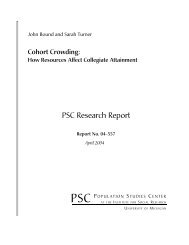1985-1987 - Population Studies Center - University of Michigan
1985-1987 - Population Studies Center - University of Michigan
1985-1987 - Population Studies Center - University of Michigan
Create successful ePaper yourself
Turn your PDF publications into a flip-book with our unique Google optimized e-Paper software.
Twenty-five Year/ al (he<strong>Population</strong> $tudie/ <strong>Center</strong>:Retro/peet and Pro/pectby Ronald FreedmanWhen the <strong>Population</strong> <strong>Studies</strong><strong>Center</strong> was founded 25 years ago,we began with some basic principlesthat have been part <strong>of</strong> the life <strong>of</strong> the<strong>Center</strong> ever since.We believed that research andteaching in the population fieldshould relate demographic processesto the social, economic, andcultural forces in which their causesand consequences were to be found.Demographic processes werealways central, but we wanted tostudy them inthe context <strong>of</strong> thesociety and the economy. Theseideas had their intellectual origins inhuman ecology, as conceptualizedby Roderick D. McKenzie and AmosH. Hawley.While we believed that demographyshould not be conceived toonarrowly, we wanted our programto be coherent and manageable.Therefore, for better or worse, wedecided not to try to be an umbrellaorganization covering all the<strong>University</strong> disciplines and pr<strong>of</strong>essionsin which population had somerole. This decision was made partlybecause <strong>of</strong> the intellectual problems<strong>of</strong> linking such diverse interests andorientations. It was made at leastequally because we wanted to avoida large bureaucratic structure whichmight consume the energies <strong>of</strong> oursenior staff. We wanted to be acommunity <strong>of</strong> scholars, and thatwould have been difficult to attain ifour numbers and the supportingstaff were very large.Another basic principle was thatthe <strong>Center</strong> would not have a unified,predetermined researchprogram. Instead, our aim was tobring together first-rate scholars andstudents and to facilitate their work,whatever it might be. This did notresult in a random distribution <strong>of</strong>work, since clusters and continuitiesin research resulted from thedevelopment through interaction <strong>of</strong>common collaborative interests anddata sets and other forms <strong>of</strong> stimulationand resource-sharing. Wedecided at an early point that wewould be concerned with populationissues in both developed anddeveloping countries. Our principalsource <strong>of</strong> funds inthe early years,the Ford Foundation, had primaryinterests in the Third World populationfield. However, Oscar Harkavy,the Director <strong>of</strong> Ford's <strong>Population</strong>Division, agreed that we couldbe free to pursue our interestswherever they led, providing thisincluded substantial work in theThird World. It was not a problemto make that commitment, since wehad staff members interested inboth kinds <strong>of</strong> population issues. Wethought that the two directions <strong>of</strong>work would complement each otherand, in retrospect, we can say thatthey did. Methodologies developedin one area proved to be applicablewith modificationsto the other.Building a staff and a program,simultaneously carrying on agrowing teaching and researchprogram abroad and at home,turned out to be a taxing enterprise.It was enormously helpful that inthese early years the Ford Foundationgave us wide latitude in theallocation <strong>of</strong> funds and renegotiatedour grants upward repeatedly as wefound that growth was more rapidthan we had initially projected it tobe.Another basic principle was thatan integral part <strong>of</strong> trainingfor ourgraduate students was an apprenticeshipwith ongoing research <strong>of</strong>the faculty and research associates.We believedthat learning to doresearch should involve learning tomeet the unexpected — for example,the data that are internallyinconsistent, the computer programthat doesn't work properly, relationshipscontrary to the initial hypothesis,data that don't meet the assumptions<strong>of</strong>the statistical modelsused, to cite a few. It also shouldinvolve experiencing the tediumand frustrations as well as thesatisfactions and excitement that are38 <strong>Population</strong> <strong>Studies</strong> <strong>Center</strong>















